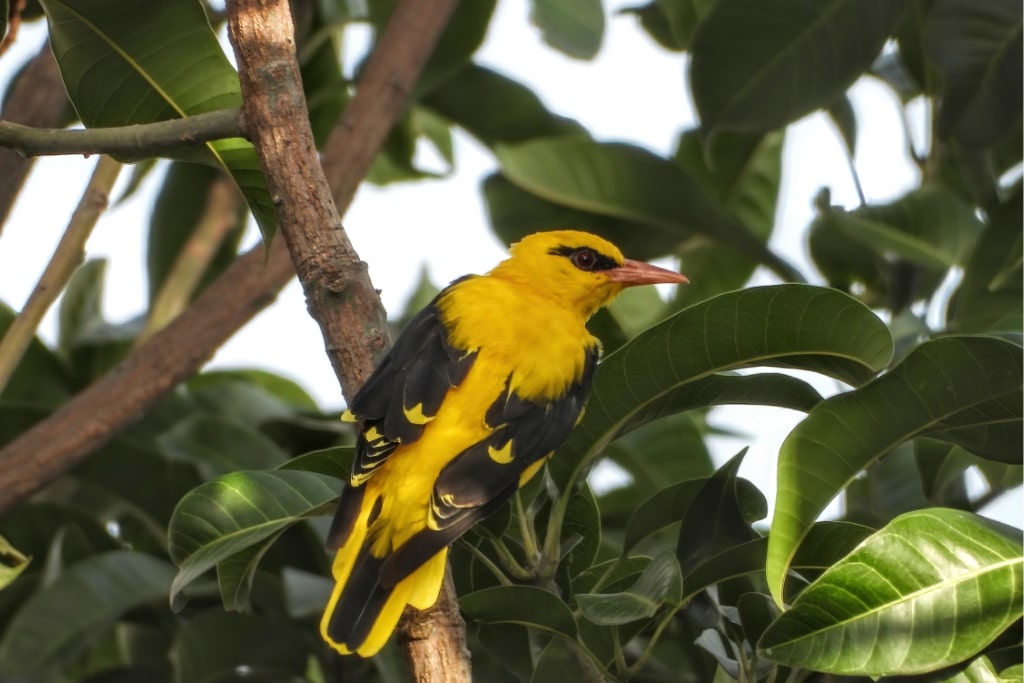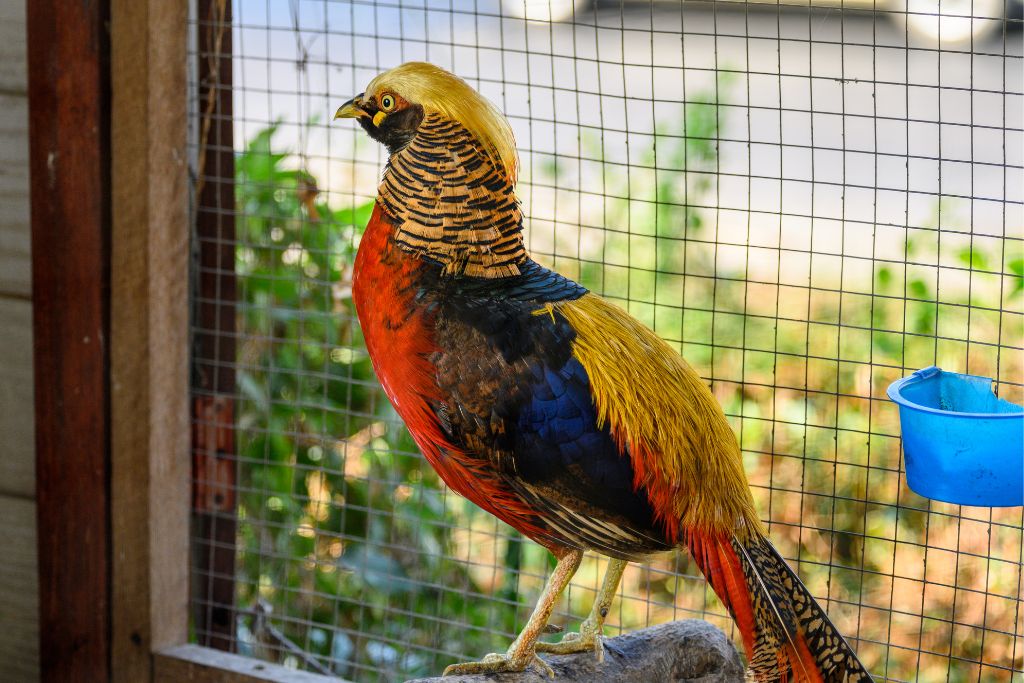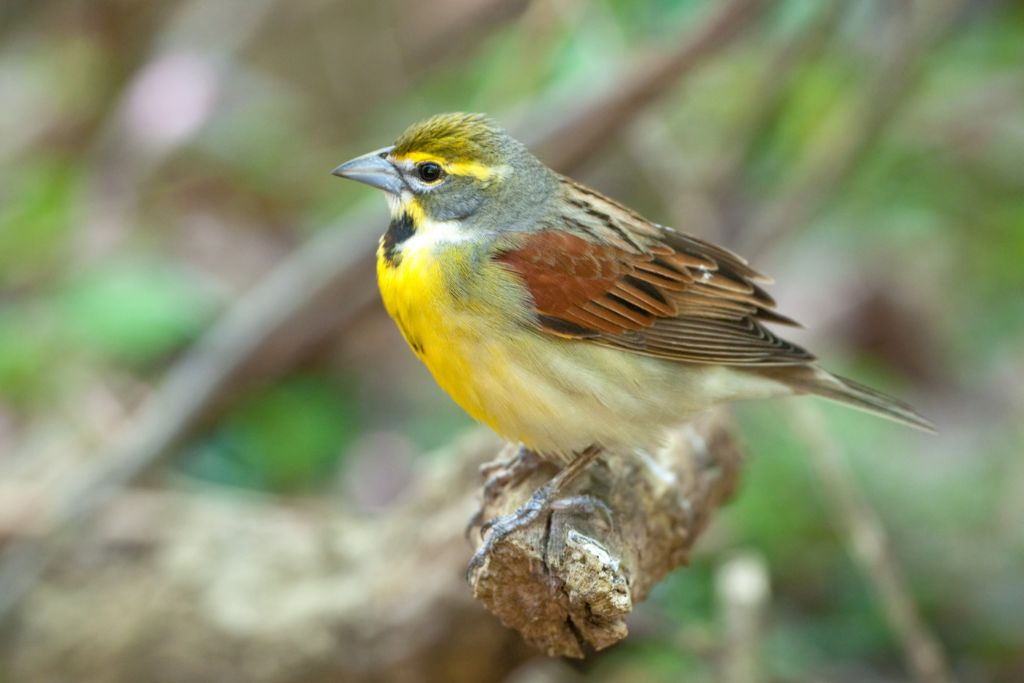Isn’t it interesting how and why some birds sport bright yellow feathers? What are the secrets hidden in their brilliant plumage? Prepare to be immersed in a rainbow of birds!
When it comes to biodiversity, yellow birds are like a ray of sunshine. From canaries to goldfinches, each feathered buddy is essential in preserving the delicate balance of our ecosystems.
Spread your inquisitive wings because we’re going on an exciting journey! We’ll explore the brilliant world of yellow birds, learning the stories behind their feathers and appreciating the rainbow of hues they add to the sky.
The Significance of Yellow Plumage in Birds
Wild birds’ yellow feathers are sunshine on their wings. Yellow plumage is fascinating because it’s rare in birds. Imagine finding a golden ticket among a sea of normal ones. Its wide visibility makes it a prominent feature that draws attention.
A bird looking for a special feathery friend may see yellow as a showy costume. They show off their superb genes and declare, “I’m healthy and ready to rock the nest-building world!”. It’s not just about being pretty; it’s about finding the right match.
Birds employ yellow as a secret weapon, despite its appearance. Yellow-feathered birds can camouflage themselves in green plants and golden sunlight. It’s hard for predators to notice these birds since they blend in. In a game of hide-and-seek with nature, these yellow-feathered birds win.
1. Canary

Meet the adorable canary whose feathers sparkle like sunshine. These cute 5-inch critters can enliven any room with their bright yellow color. Canaries are small painters with magnificent yellow, orange, and white plumage.
They are great singers, and their tunes differ. These birds are beautiful and loud. Coal mines utilized canaries as natural gas detectors. Mine workers were protected by their sensitivity to harmful gasses.
They like seeds, fruits, and insects. Female canaries lay their eggs in warm shrubs or tree nests. These nests are painstakingly built from feathers and grass to provide a cozy home for the new canary family members.
Wild canaries live in the Canary Islands, Azores, and Madeira. These energetic tiny animals enjoy flying over fields and gardens, demonstrating their acrobatic skills. Social canaries interact happily in small groups. These feather and grass nests are painstakingly made to provide a cozy home for the new canary family members.
2. Goldfinch

Small and colorful, the goldfinch dances across the skies. The bird’s vibrant yellow and black wings are like a little sunshine. In addition to its beauty, its twittering gives a lively song to the air.
Social goldfinches talk in high-pitched, tinkling cries. They love seeds, especially sunflower seeds. Imagine them as bird gourmets who choose the best garden delights.
Goldfinches are frequent travelers. You can find them in North American meadows and woods. These flying acrobats do elegant maneuvers. They venture throughout neighborhoods, looking for a cozy restaurant due to their restless existence.
3. American Goldfinch

The bright yellow American goldfinch is a lively bird. They are small, 4 to 5-inch-long feathered companions with a 7 to 9-inch wingspan. Females are olive-brown, while males are brilliant yellow, especially during breeding season.
These lovely birds are found from Southern Canada to Northern Mexico. They appreciate meadows, gardens, and fields to fly acrobatically. American goldfinches tend to gather in flocks and enjoy eating sunflower seeds. These birds wait until late summer to reproduce, eating thistles and other seeds as a mainstay.
American goldfinches are meticulous nest builders. They strengthen their cup-shaped nests in trees using plant fibers, grasses, and spider silk. Well-made nests may survive strong winds. These birds patiently wait to start their families when seeds are abundant and give their babies a healthy meal.
They eat seeds, mainly thistles and sunflowers, unlike most birds. Another intriguing characteristic is that late nesting correlates with late summer seed availability. This timing ensures chicks have enough nourishment.
4. Yellow Warbler

Meet the cheerful yellow warbler with summer-colored feathers. Their wingspan can exceed 7 inches, and these small birds are 4 to 5 inches long. Females are yellow-green, while males are bold yellow.
Although little yellow warblers are powerful travelers, they make an extraordinary trek from Central and South America to North America for the summer. Their happy, persistent music that fills their habitats is another cool characteristic.
These energetic birds thrive in many habitats as social butterflies. Look for them in forests, marshes, and your home garden. They are not picky eaters, either. Their varied diet includes insects and berries.
5. Yellow Oriole

The yellow oriole is a cheerful bird. Imagine a 7-inch bird with bright yellow feathers and black wings and tail—a small flying ball of brightness with silky feathers and a delicate, slightly curved beak.
These birds sing and mimic bird songs and environmental sounds. An ethereal imitator in the trees! They also love food, nectar, and insects.
Yellow orioles are migratory. They inhabit Mexico, Peru, and Brazil. These tiny jet-setters relax in forests, gardens, and even metropolitan parks. They love performing and displaying their feathers and singing skills to everyone who will listen.
6. Western Tanager

Red heads, yellow bodies, and black wings make male western tanagers stand out. Females are more subdued, wearing yellowish-green clothes to blend in. Small fashionistas, these 7-inch birds are avian supermodels.
Like snowbirds, they migrate from North America to Mexico and Central America for the winter. They catch insects mid-air by quickly moving between the trees. It’s like watching a small, feathered acrobat perform.
Western tanagers are nature lovers. Occasionally, you can see them in coniferous forests, woods, and gardens. They’re friendly and commonly spotted in small groups or pairs, chirping like they’re talking.
These birds eat insects, fruits, and berries, demonstrating their broad appetite. When they start a brood, these birds build cup-shaped nests in towering trees’ comfy branches. They prefer quiet, green neighborhoods to high-rises.
7. Prairie Warbler

The prairie warbler is a bright spot amid the grasslands. Imagine a 4.5- to 5-inch bird in brilliant yellow with black streaks that resemble an avian mask.
The prairie warbler is a bird-singer. Their happy, buzzy chorus fills the plains. They sing to attract mates and claim their territory, not only for fun. It’s like a concert to find love and define their area.
After reproducing in the East and South, they travel to Central America and the Caribbean for the winter. Their tropical vacations are like snowbirds escaping the cold.
They eat insects and spiders, demonstrating their broad diet. These little architects build their nests in bushes or low branches when they settle down and create a family. With fine grasses, plant fibers, and feathers, the females decorate their soon-to-be-born chicks’ homes.
8. Yellow-Headed Blackbird

The yellow-headed blackbird is a colorful bird. As its name implies, the male has a bright yellow head against its black body and wings. This colorful bird is easily identified by its long, pointed bill and white wing patch. The female is striped brown and has more muted hues.
These blackbirds make their nests over the water instead of in trees like other birds. In marshes and wetlands, they make hanging baskets from dense foliage. Their unusual nesting style protects eggs from ground predators.
In North America, these birds are widespread. Hearing their sounds from afar when they breed in marshes, meadows, and wetlands is possible. Especially during nesting season, they establish enormous colonies.
9. Cape Weaver

South African cape weavers are beautiful with their bright, yellow feathers and dark patterns. These sparrow-sized birds are remarkable, especially the males with bright yellow plumage and orange cheeks.
Cape weavers’ nest-building talents are amazing. These little architects build elaborate grass-and-twig nests. Interestingly, each male weaver makes many nests to impress female mates with their artistry. Males compete to build the best nest to attract mates.
These little birds eat seeds, fruits, and insects. They thrive in gardens, farmlands, and cities due to their adaptability.
Cape weavers in South Africa prefer wide grasslands and savannas. These gregarious birds reside in colonies, creating a lively atmosphere with their tweeting and fluttering.
10. Eastern and Western Meadowlark

Lovely blackbird songbirds are the eastern and western meadowlarks. Visualize a little bird with a streaked brown back, brilliant yellow chest, and black “V” on its collar. This is the eastern meadowlark.
The melodic whistles and gurgles of both meadowlarks resound over pastures. It is amazing that each meadowlark has its own tune, like a feathered musician. These birds are outstanding singers and imitators, sometimes using environmental noises in their songs.
They build carefully, including a roof to protect their chicks. These birds are amazing parents, continuously hunting insects for their hungry chicks. Meadowlarks eat insects, seeds, and small fruits, showing their versatility in grassy terrain.
The eastern meadowlark lives in Eastern North America, whereas the western meadowlark is in the West. They love grasslands and prairies. Their activity is fascinating, as they sit on fence posts or shrubs to display their plumage while watching the grass below for insects.
11. Yellow-Throated Vireo

A lovely tiny bird, the yellow-throated vireo has bright yellow feathers around its throat, like a necklace. While its belly is creamy white, its back is olive and green. Yellow-throated vireos are like bursts of sunshine through cold forest gloom!
It sings well and sounds like a pleasant tune in the woods. These birds are skilled mimics, echoing other birds and insects. They eat caterpillars, spiders, and other insects, making their diet intriguing. These grass, twigs, and spider silk-like master architects build comfy egg homes.
Yellow-throated vireos are woodland VIPs in habits and behavior. They spend summers in Eastern North America, loving the mild weather. Winter break in Central America is like a vacation.
12. Golden Pheasant

The golden pheasant’s long, flowing tail resembles a feathered cloak and is full of brilliant colors. Males stand out with their orange and red bodies, yellow and green heads, and gold crowns. The females are more modestly clad in mottled brown to blend in.
This bird comes from Central China’s mountains. In addition to their beauty, these birds can fly and rest in trees overnight to avoid predators.
Golden pheasants have a naturalistic lifestyle and behavior. They display their elegant plumage in lush woodlands and tall grasslands. Seeds, berries, and insects are welcome to these birds. They nest in tall grass on the ground. The mama pheasant carefully lays her eggs, and the youngsters follow her like fluffy, feathery shadows.
13. Western Kingbird

The western kingbird is a colorful bird with a unique personality. This bird stands out in the sky with its sleek yellow-gray feathers. It’s bird royalty with a sharp crown.
Western kingbirds are superb aerial acrobats as well as having a lovely face. Its ability to catch insects mid-flight makes it the bird community’s superhero, zipping around and saving the day. These birds communicate well, another amusing fact.
They have a varied diet. Their menu includes juicy insects and tiny fruits. They build their nests in trees or bushes when they settle down. These grass-twig-feather nests are pleasant homes. Parents alternate warming the eggs until hatching.
They claim Western North America’s deserts and meadows. These birds may be perched on fences or utility wires, watching. Like the neighborhood watch, these birds aren’t shy and keep order.
14. Common Yellowthroat

Common yellowthroats are cute, tiny birds with vivid yellow throats. These small birds are like sunbeams in the grass. You may see them fluttering around ponds and marshes.
They sing a happy “witchety-witchety-witchety” song. Males utilize their harmonious songs to attract partners and establish territory, not merely for amusement. Small but powerful, they migrate from Canada to Central America each year.
Many insects, spiders, and caterpillars make up a common yellowthroat’s diet. They jump around among low plants, utilizing their keen beaks to grab their preferred prey. These birds build their homes like architects.
15. Dickcissel

The lovely dickcissel is distinguished by its black “V” mark on a brilliant yellow chest. They’re roughly the size of your hand and fly with a wingspan that looks like they’re waving hello.
Singing from lofty grass or fence posts is a favorite perch for dickcissels. Think of a modest field bird concert. It’s even cooler that each dickcissel sings differently. They devour seeds, insects, and fruits without discrimination.
Dickcissels are frequent movers. Their summers are spent in Central North America, from Canada to Mexico. The winter vacationers flock to South America for warmer weather. These birds are social butterflies who gather with pals. They’re bold and like to impress with their brilliant colors.
Conservation and Protection
Yellow-feathered birds face challenges as their habitats disappear. These birds struggle to obtain food and nest due to human movement. Climate change is another huge issue.
Saving small yellow birds’ habitats and the cooling of the earth makes you a superhero! Find and assist bird rescue groups. Communicate why yellow birds are cool and why we must defend their homes.
Final Thoughts
These birds are varied in size and have unique abilities. Some have wings for flight, while others have long beaks for reaching small spaces. Because of their incredible versatility, these yellow birds are extraordinary.
Protecting yellow birds is like applauding them for being amazing. These lovely birds live by learning and appreciating the things around them. We can protect these amazing species and give them a peaceful home in our beautiful globe.
FAQs
How Rare is a Yellow Bird?
Yellow birds aren’t super rare; you can find them in various species, like canaries and goldfinches.
Why Do Yellow Birds Sing?
Yellow birds sing for communication—mating, marking territory, and alerting to danger. It’s their social language.





